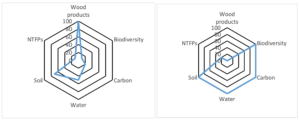Module 13: Forest Landscape Planning
Topic 13.2: Tradeoffs
Explicit recognition of tradeoffs associated with all silvicultural treatments and land uses in general allows increased rationality in their assessment, as opposed to attempts to maintain all values everywhere all the time. To envision some of these tradeoffs, consider the concentric polygons in Figure 13.2.1, the outermost of which represents the reference state or goal (i.e., 100% delivery of that value).

Figure 13.2.1. A suggested approach to disaggregation of sustainable forest management into some of its component values with emphasis on biophysical attributes. The concentric polygons refer to percent values of the indicators relative to a primary or other reference forest baseline. The irregular lines on panels represent the tradeoffs associated with different uses of a stand. The left-hand panel indicates 100% satisfaction of the wood product yield goal associated with substantial losses in all of the other values except soil conditions. The right-hand panel represents a stand use that delivers no harvestable wood or non-timber forest products but retains the maxima of all of the other values.
Management, by definition, requires that when some species, conditions, processes, or values are managed for, some other species, conditions, processes, or values are managed against. In other words, tradeoffs are as inherent to the act of management as they are to resource exploitation. In tropical forests, SFM requires consideration of sufficiently large landscapes for all values to persist, enabling sustainable wood production, sufficient ecosystem services for communities, and no losses of species. For this purpose, areas within the landscape used for different purposes are partitioned into use-categories, often with different values or benefits to society (Figure 12.2.1). For example, intensively managed plantations have limited value for biodiversity but high value for commercial wood production, while protected areas are the opposite. These differences in value-maintenance among land-use categories are represented by the blue value lines inside the tradeoff polygons; value lines that approach the outer perimeter of the polygon represent value maintenance relative to the primary forest baseline. Indicators for each of the six criteria are landscape specific and depend on the specific circumstances and the selected objectives for each forest category. For example, a key indicator for protected areas might be elephant population persistence, while for a plantation, indicators might be a certain amount of wood, fuel, or rubber produced per year. Regardless of the number of forest land use categories, each can be evaluated on the basis of the same six criteria in full recognition of the different objectives for which different land-use categories are managed. For more complete assessments of sustainability at the landscape level, criteria need to be added that capture the social, economic, and additional environmental values. Extension of this approach to non-forest land uses is possible, but will likely involve specification of new evaluation criteria.
